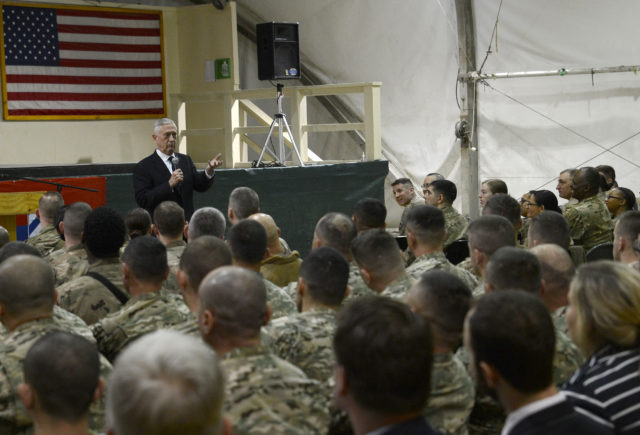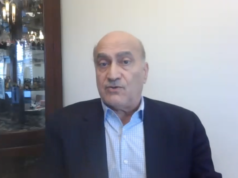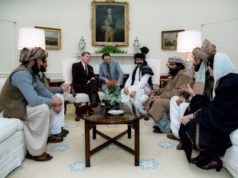
(Editor’s Note: American forces have spent 17 years, costly in lives and money, fighting in Afghanistan. The following article, intended to stimulate strategic reexamination of our involvement, focuses on accountability for achieving objectives and posits an unusual “exit strategy.”)
General Electric Co. fired its chief executive officer, John Flannery, after 12 months because “the board had grown frustrated with the slow pace of change.” American taxpayers know exactly how the GE board felt whenever they see another headline about Afghanistan.
In September 2018, the United States had been in Afghanistan for 17 years and there was no end in sight. The CIA, the spearhead of U.S. forces, reached Afghanistan’s Panjshir Valley on Sept. 26, 2001 just more than two weeks after al-Qaeda’s 9/11 attacks in New York City and Washington, D.C. Military special operations forces arrived shortly after, and the combined CIA-military team connected with the Northern Alliance to rout the Taliban and liberate Kabul by mid-November.
Maybe we should have quit while we were ahead: the tab so far is $840 billion for military operations, $126 billion for reconstruction, probably another $1 trillion for veterans’ health care and more than 2,200 American killed and 20,000 wounded. The annual cost is $50 billion, more than the defense budget of the United Kingdom.
On Sept. 2, 2018, Gen. Scott Miller assumed command of the NATO forces in Afghanistan. Since January 2002, the NATO command in its various guises has had 16 commanders, Americans commanding exclusively since 2007.
President Donald Trump isn’t comfortable with the extended mission in Afghanistan. He wants to win, but probably doesn’t see a way out, primarily because most of his advisors don’t know any means other than “money and time.” So, in August, he authorized an additional 4,000 troops for training and counter-terrorism missions.
American taxpayers were indulgent for the first decade of the Afghanistan project, but President Barack Obama gave notice the tide had turned when he suggested America pursue “nation building here at home.” President Trump pithily seconded that when he asked, “What the f**k are we doing there?”
Maybe it’s time Trump gave his top three officials in country, the ambassador, the commander of NATO’s Operation Resolute Support, and the USAIS Mission Director 12 months to show demonstrable progress. But how will he determine success?
The war has spawned a flood of measurements that tell us more and more about how we’re “not winning” in the words of Defense Secretary James Mattis. If you want to measure days of training, improvised explosive device (IED) attacks, or number of people displaced by the fighting, we’ve got you covered. Adding to the confusion, competing assessments by the Department of Defense, the Special Inspector General for Afghan Reconstruction (SIGAR), and the Lead Inspector General for Overseas Contingency Operations disagree on the meaning of trends.
How can the president measure the leaders’ success or failure? By looking at the amount of territory the Afghan central government controls or influences, currently under 60 percent of the country? Or looking at the level of opium production? According to the latest report by the U.N. Office on Drugs and Crime “opium production in Afghanistan increased by 87 percent to a record level of 9,000 metric tons in 2017 compared with 2016 levels.”
Up to now, the senior leaders, diplomats, generals, and reconstruction officials worked as if they had no deadline, which in the trade is known as “conditions-based.” Instead, the leaders should be given a deadline and promise of no micromanaging by Washington. There’s a lot going on beneath the surface of those metrics because they really measure the provision of public safety in Afghanistan’s ungoverned spaces, so the leaders should have a free hand to do what they must to succeed.
Twelve months will keep the NATO forces in place through the next Afghan presidential election on April 20, 2019. And speaking of presidential elections, the 2020 vote in the U.S. is on Nov. 3, 2020, so a 12-month performance period for the three leaders will give the Republican candidates one year to campaign without having to promise progress in Afghanistan if there is none to be had. After almost two inconclusive decades there’s no shame in allowing domestic political considerations to drive Afghanistan policy. In fact, it’s about time.
And facile assurances, like from Afghanistan’s Chief Executive Abdullah Abdullah that it “won’t be a 50-year engagement,” indicate some of that country’s leaders don’t understand most Americans think it’s unlikely the United States will prevail, whether the strategy is dressed up as “time-based” or “conditions-based.” They need the motivation the ticking clock provides, and the understanding that this may be the end of their claim on America’s attention.
Plan Illuminates Current Short-comings
In August 2018, U.S. Defense Secretary James Mattis kiboshed Erik Prince’s plan to privatize the war in Afghanistan. Prince called the fighting “an expensive disaster for America.” But we may not have seen the last of the Prince plan, which is forthrightly titled “An Exit Strategy for Afghanistan.”
Despite the cost in dollars and lives, there hasn’t been much progress, as noted above in figures on central government control of the countryside and increasing illegal opium production. In questioning the purposes of the continued U.S. military presence in Afghanistan, President Trump was channeling many Americans.
In parallel with the 4,000 troop increase authorized by President Trump, the administration slashed assistance to Pakistan, the state sponsor of the Taliban. This won’t change Pakistan’s behavior in Afghanistan, but at least America won’t continue to insult itself by funding its enemy.
U.S. diplomats have started direct talks with the Taliban while reiterating that the end to the conflict will only come through an intra-Afghan settlement. At the same time, Uzbekistan’s diplomats hosted talks with Taliban representatives as part of Tashkent’s initiative to include Afghanistan in Central Asia, and to give the Taliban an interlocuter other than Pakistan.
Trump’s pro-intervention advisors probably want to block him from deciding to withdraw and upsetting next spring’s Afghan presidential election. Twice-postponed parliamentary elections were held successfully in late October. Retaining U.S. forces through the Afghan presidential balloting would give the new NATO commander time to make progress (known as “calendar creep”). But Afghan President Ashraf Ghani’s opponents in the Coalition for the Salvation of Afghanistan may hand Trump an opportunity to break out.
The Coalition, an assembly of the minority Tajiks, Uzbeks, and Hazara, with Pashtun leadership, will be a serious challenge to Ghani in next April’s vote, and it may try to invalidate the October 2018 parliamentary election and call a traditional Loya Jirga to unseat Ghani. If the Coalition uses the extra-legal Loya Jirga to oust Ghani, Trump would have the justification he needs to go to the American people with a decision to quit and cut America’s considerable losses, especially if he is bolstered by a pessimistic National Intelligence Estimate.
So now comes Erik Prince, the man everyone loves to hate, with a plan to privatize and streamline the tasks now being performed by about 14,000 American and 8,000 NATO troops and over 26,000 contractors. Prince earned his notoriety in Iraq when his security company, Blackwater Worldwide, was involved in a shooting incident at Baghdad’s Nisour Square that left 17 innocent bystanders dead and caused Blackwater’s expulsion from the country. Prince, in his defense, claims he never lost a client which, if you were protected by his teams, is probably the most significant criterion.
Prince proposes to replace the NATO forces and their support contractors with 6,000 contractors, all special operations veterans, and 2,000 U.S. special operations troops, who will provide QA for the contractors and unilateral direct-action capability. The mentor-contractors will stay with their assigned Afghan National Army battalions for a minimum of three years. Two-thousand contractors will operate aircraft for medical evacuation and close air support and will staff two Western-style combat surgical hospitals that would also treat wounded Afghan soldiers. The contractors and U.S. forces would be subject to the Uniform Code of Military Justice and Afghan law, and contractor medical care would be provided by Defense Base Act insurance, which is current practice for contingency contracts.
The plan includes a governance support unit that will provide logistics to the force and, very importantly, prevent payment to Afghanistan’s “ghost soldiers” and the skimming of soldiers’ pay by their commanders, perennial corruption problems in Afghanistan’s military.
The most remarked upon feature of the plan was Prince’s suggestion that the effort be led by a “viceroy” who would answer directly to the president and command all military, diplomatic, and intelligence assets in Afghanistan. This is known as “unity of command,” and has never existed in America’s long project in Afghanistan. That person would need experience with the military and intelligence agencies, but no candidate may satisfy all the bureaucracies so the president (and Congress) will have to back it up by giving the viceroy hire-and-fire authority and control of the budgets.
Another noted feature was contracting the effort under Title 50 of the United States Code which is the authority for the security services, such as the Central Intelligence Agency (CIA), but also for most military operations. This may expedite the contract award process, but particular attention will be required for “contract administration,” that is, ensuring the vendor completes the terms and conditions of the contract. As the military, the diplomats, and the reconstruction officials have been unable to define “success” in Afghanistan, the contracting officer and the vendor may be left to their own devices.
And using contractors has one big benefit for a government: their deaths are pretty much off the radar, especially if they aren’t American (and a share of Prince’s force will be non-American). News media report the death of every deployed military member, even if he or she dies in a vehicle accident on base, but dead contractors go unnoticed. Two hundred and fifty-seven American contractors died in Iraq from 2003 to 2011 but received far less attention than fatalities among soldiers they supported.
The opportunity to mine Afghanistan’s trove of rare earth elements was highlighted in Prince’s plan, which immediately drew accusations of plunder. There is wealth to be had: Russian, British, and American geologists have found that Afghanistan has enormous untapped mineral resources, possibly valued at $3 trillion.
The minerals are there, but there’s no way to mine them, so they’re effectively worthless. And there’s no way to get them out because the country is violent and corrupt, which scares away investors. Outsourcing may be the last chance to recover Afghanistan’s mineral wealth for its people. It will also chip away at China’s control of a significant share of the world’s rare earths.
Meanwhile, Afghanistan’s government has some concerns the United States must address:
• Is the plan legal under international law?
• Will using foreign contractors encourage local warlords to circumvent the newly-formed democratic institutions in the country?
• Who will be accountable for the success or failure of outsourcing a military campaign?
• How will the government of Afghanistan provide oversight of military operations on its territory?
• Will outsourcing be seen as a for-profit corporation taking control of the conflict and selling war as a product, dooming prospects for peace and reconciliation in the country?
The regional powers, China and Russia, and the active neighbors such as Pakistan and Uzbekistan, may stop their support of the peace process if they interpret outsourcing as indicative of waning U.S. interest.
Criticism of Prince’s plan runs up against the ticking clock that is close to chiming “20 years” so Trump may soon run out of patience and present Kabul (and U.S. officials) with a “take it or leave it” proposal. There’s no U.S. political constituency for continued loitering in Afghanistan and Trump won’t lose any votes in 2020 if he says he gave it his best shot but getting out now is right for America. Secretary Mattis is concerned that outsourcing may make NATO allies in our Afghan coalition jump ship, but how many American lives and dollars should we pay for Latvia’s 37 troops?
Detractors of a new approach may say the sacrifice of our GIs will be dishonored by resorting to “mercenaries,” but the sunk cost of the dollars, dead, and wounded shouldn’t stop us from examining alternatives after 17 years fighting a war we are “not winning” according to Sec. Mattis.
Prince has suggested a “test drive” of his proposal which would see contractor deployments to Nangarhar and Helmand provinces. Nangarhar is an egress route to and from safe havens in Pakistani, and Helmand is the Taliban’s financial center of gravity where one-third of the arable land is used for poppy cultivation. That would provide Washington some interesting lessons learned whatever the outcome but, given resistance inside the U.S. government, it will require an impartial evaluator who will also consider Afghan concerns.
Prince’s plan gives the United States an opportunity to try a new strategy in Afghanistan instead of spending another year while yet another new NATO commander gets acquainted with his job. It may prompt Washington to consider three options: Prince’s original plan, an Afghan Ring Road reconstruction plan suggested by Gary Anderson, which could strengthen the country’s general infrastructure and commercial integration with Central Asian neighbors, or the “decent interval” option, providing mentoring and training to the Afghan army so, if worse comes to worst, the United States will be several years removed from a Taliban takeover.
James Durso is Managing Director of Corsair LLC and was a professional staff member for the Commission on Wartime Contracting in Iraq and Afghanistan. This article is an edited combination of his “General Electric’s version of accountability should be used in Afghanistan” and “Is Erik Prince Pointing the Way Out of Afghanistan?” which appeared in the Oct. 4, 2018 and Sept. 28, 2018 editions of The Hill and Real Clear Defense, respectively.





